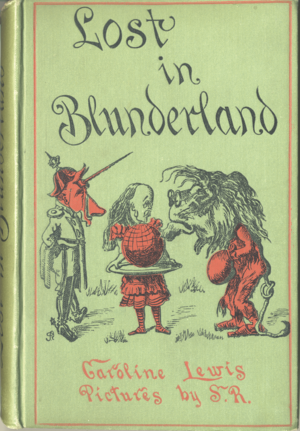Lost in Blunderland facts for kids

First edition cover of Lost in Blunderland
|
|
| Author | Caroline Lewis (Edward Harold Begbie, J. Stafford Ransome, and Michael Henry Temple) |
|---|---|
| Country | United Kingdom |
| Language | English |
| Genre | Fantasy novel, parody |
| Publisher | William Heinemann |
|
Publication date
|
1903 |
| Media type | Print (hardback) |
| Pages | xvi, 150 |
| Preceded by | Clara in Blunderland |
Lost in Blunderland: The Further Adventures of Clara is a fantasy novel written in 1903. It was published by William Heinemann in London. The book was written by "Caroline Lewis," which was a pen name (or pseudonym) used by three authors: Edward Harold Begbie, J. Stafford Ransome, and Michael Henry Temple.
This novel is a parody of Lewis Carroll's famous books, Alice's Adventures in Wonderland and Through the Looking-Glass. A parody is a funny imitation of something, often used to make a point. Lost in Blunderland is also a sequel to an earlier book called Clara in Blunderland. Both books use humor to talk about the British government's actions during the Second Boer War.
What is Lost in Blunderland About?
Lost in Blunderland makes fun of the government led by Prime Minister Arthur Balfour. A Prime Minister is the main leader of a country's government. In the story, Prime Minister Balfour is shown as a little girl named Clara.
Characters and Their Real-Life Meanings
Many characters in the book represent real British politicians from that time.
- The Red Queen in the story stands for Joseph Chamberlain.
- Crumpty-Bumpty represents Henry Campbell-Bannerman.
- Other characters, like the Lion and the Unicorn, represent countries. The Lion stands for Britain, and the Unicorn stands for Germany.
The authors jokingly said that their book had no political meaning. They wrote that people were "prying" (being too curious) if they thought there were political messages. But the book was clearly a funny way to comment on politics.
The Book's Illustrations
The book includes 40 drawings. These drawings were made by J. Stafford Ransome, who was a journalist. He signed his drawings as "S.R." His artwork was inspired by the original drawings of John Tenniel from the Alice in Wonderland books.

